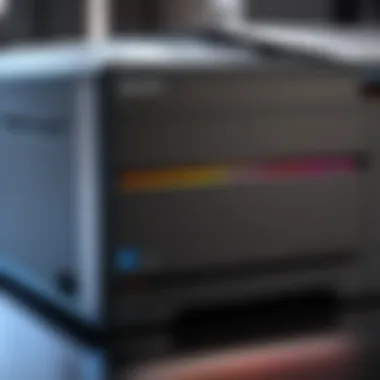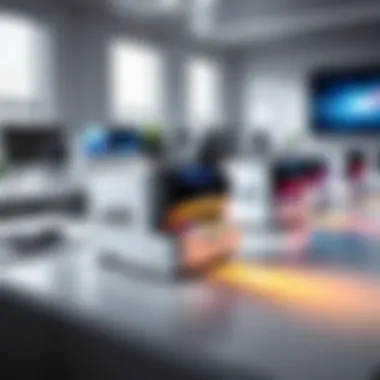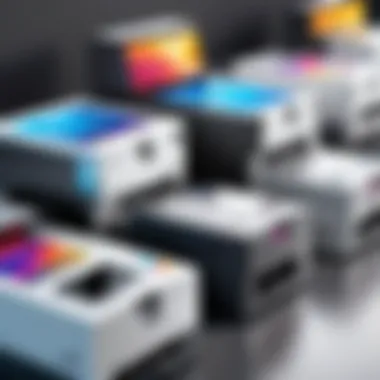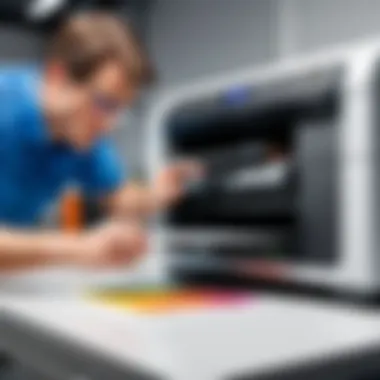Comprehensive Guide to 11 x 17 Color Laser Printers


Intro
The demand for larger format printing is growing in various professional settings, making 11 x 17 color laser printers more essential than ever. These printers serve diverse needs, from producing high-quality marketing materials to creating detailed architectural designs. Understanding the features and performance metrics of these machines allows IT professionals and tech-savvy users to make informed decisions that align with their organizations’ needs.
A key aspect of selecting a printer goes beyond the basic specifications; it involves evaluating how well the machine integrates into your existing workflow. This guide aims to provide an in-depth look at the hardware and software dimensions of 11 x 17 color laser printers, focusing on what makes them suited for modern workplaces.
Hardware Overview
Specifications
When exploring 11 x 17 color laser printers, certain specifications stand out. Typical models feature print resolutions up to 2400 x 1200 dpi, which enhances the quality of images and text. Additionally, these printers generally support various media types, including heavier cardstock and different finishes, catering to a range of projects.
Some key metrics include:
- Print Speed: Usually ranges from 20 to 30 pages per minute (ppm).
- Monthly Duty Cycle: Indicates maximum recommended pages printed per month, often between 30,000 and 80,000.
- Connectivity Options: Commonly include USB, Ethernet, and Wi-Fi options for versatile use.
Performance Metrics
Performance metrics vary among models, but assessing them can direct you to your ideal choice. First Page Out Time (FPOT) is one metric that indicates how quickly the printer makes the first print after receiving the job. Fast FPOT values can significantly improve productivity. Toner Yield is another important factor; it refers to how many pages a toner cartridge can produce before needing replacement. High-yield toner cartridges will often lower your total printing costs.
"Selecting the right 11 x 17 color laser printer can substantially influence the efficiency of your office workflow, ensuring consistency and reliability in your print jobs."
Software Analysis
Features and Functionality
Modern 11 x 17 color laser printers come equipped with features that enhance usability. Functions like duplex printing, which allows both sides of the paper to be printed, save time and costs on paper consumption. Some models also offer mobile printing capabilities, enabling users to print directly from smartphones or tablets, thereby increasing flexibility in a fast-paced environment.
User Interface and Experience
User experience can significantly affect an organization's efficiency. Many printers offer touchscreen displays, which simplify navigation through printer settings and job management. Moreover, instructional prompts guide users on how to resolve common issues, further enhancing the user experience.
A solid choice in the 11 x 17 category should prioritize intuitive interfaces, reducing training time and minimizing disruptions in workflow.
With the aforementioned considerations in mind, selecting an appropriate printer can provide not only the necessary performance but also enhance overall efficiency in various professional contexts. Understanding these aspects is crucial for IT professionals who aim to adapt to evolving printing needs.
Preface to x Color Laser Printers
In the realm of modern printing solutions, 11 x 17 color laser printers emerge as a vital asset, particularly for businesses that require high-quality output on a larger scale. These printers offer a comprehensive approach to meeting diverse printing needs, addressing the demand for both versatility and efficiency. The significance of this topic extends beyond mere convenience; it encapsulates critical aspects of workflow enhancement, cost management, and operational effectiveness.
The 11 x 17 format, often referred to as tabloid size, is especially beneficial for printing marketing materials, architectural designs, and various graphical content that demand larger canvases. One key advantage of utilizing color laser technology lies in its ability to produce vibrant colors and sharp text that can elevate professional presentations and documentation.
Moreover, understanding the features and capabilities of these printers becomes essential for IT professionals and tech enthusiasts. The complexities of various models, such as print speed, resolution, and connectivity options, shape how well these devices can integrate into existing office infrastructures.
"Investing in an 11 x 17 color laser printer is not just about purchasing a machine; it's about enhancing productivity and maintaining a competitive edge in a digital environment."
When considering the purchase of these printers, several pivotal factors must be evaluated. Performance metrics, including speed and print quality, play a crucial role in ensuring that these devices meet specific business requirements. Additionally, evaluating total cost of ownership is important, encompassing not just the initial purchase but also ongoing maintenance and supplies.
In summary, 11 x 17 color laser printers stand at the intersection of functionality and efficiency in professional settings. By grasping their features and applications, one can make well-informed decisions that align with both practical needs and long-term goals.
Benefits of Color Laser Printing
Color laser printing has garnered recognition for its practical advantages, especially in professional settings where quality and efficiency are crucial. The following sections will detail the significant benefits offered by this technology, drawing attention to its impact on workflow and output.
High-Quality Output


One of the paramount benefits of color laser printing is the high-quality output it can produce. This technology employs a complex process involving lasers, drums, and toner that work together to create crisp images and text. The resolution of color laser printers typically ranges from 600 dpi to 2400 dpi, which enables precise reproduction of graphics and detailed text.
In contrast to inkjet printers, where ink can bleed and smudge, laser printers rely on a fusing process that bakes the toner onto the paper. This method results in prints that are less prone to smearing and fading over time. For professionals in graphic design, marketing, or any field requiring high-caliber documents, the ability to showcase vibrant colors and intricate details is indispensable.
Speed and Efficiency
The efficiency of color laser printers is notably superior, especially when it comes to large print jobs exceeding standard document sizes. With print speeds commonly exceeding 20 pages per minute, these printers can handle demanding tasks without the typical downtime associated with inkjet models.
Moreover, many color laser printers feature automatic duplexing, allowing for quick double-sided printing, which can further enhance productivity. This capability not only saves paper but also speeds up the overall printing process, making them a solid choice for environments where time is of the essence.
Cost-Effectiveness Over Time
When assessing the total cost of ownership, color laser printers offer compelling advantages over their inkjet counterparts. While the initial investment may be higher, the longevity of toner cartridges compared to ink cartridges provides savings in consumables over time. Toner cartridges tend to yield a greater number of pages, which can be advantageous for businesses that print large volumes.
Additionally, many modern laser printers come equipped with energy-saving features and efficient imaging technology, further reducing operational costs. In fast-paced workplaces, the combination of high performance and low cost per page makes color laser printers a wise financial choice.
"Investing in color laser printing technology often leads to long-term savings and efficiency, beneficial for any professional environment."
In summary, the benefits of color laser printing extend beyond mere convenience. High-quality output, speed and efficiency, along with cost-effectiveness, tie into a comprehensive system that can critique how businesses manage their printing needs. Understanding these elements is essential for IT professionals and tech enthusiasts tasked with selecting the most suitable printing solutions.
Key Features of x Color Laser Printers
When selecting an 11 x 17 color laser printer, consider its key features. These elements play a crucial role in defining the printer’s usability, efficiency, and overall output quality. Understanding these features helps users make informed decisions tailored to their specific needs. The construction of a robust printer involves examining details such as print resolution, print speed, paper handling capacity, and connectivity options. Each one of these aspects impacts not just the printer's performance but also the practicality in various environments.
Print Resolution
Print resolution specifies the quality of the output. It is usually measured in dots per inch (DPI). A higher DPI translates to finer detail and sharper images. For IT professionals and tech enthusiasts, knowing the required print resolution is vital when engaging in projects that involve graphics or intricate designs. For instance, if a user aims to print high-resolution photographs or detailed illustrations, they should choose a printer with at least 2400 x 1200 DPI. This ensures clarity and color vibrancy.
Print Speed
Print speed, measured in pages per minute (PPM), indicates how quickly a printer can output documents. For busy offices or environments that require frequent printing, speed is an important consideration. A faster printer increases productivity and reduces downtime. Some printers offer varying speeds dependent on the type of document, whether it’s text-heavy or graphics-rich. Selecting a printer that balances speed and quality is essential; high speed should not come at the expense of print quality, especially in professional settings.
Paper Handling Capacity
Paper handling capacity reflects how much paper the printer can store and process. This varies from one model to another. Having a larger input tray reduces the need for constant reloading, which is beneficial for high-volume printing environments. Furthermore, printers with multi-function capabilities could also handle various paper sizes. Users should consider whether they frequently print on different media types, such as glossy paper, or specialized stock. Inadequate capacity could lead to interruptions and inefficiencies in the printing workflow.
Connectivity Options
In an increasingly connected world, a printer's compatibility with multiple connectivity options is significant. Many modern printers offer USB connectivity, while others support wireless connections such as Wi-Fi and Bluetooth. Some printers integrate with cloud services, allowing remote access to print files directly from various devices. For IT professionals, knowing the available connectivity options is critical, especially when setting up a networked printing environment. This enhances flexibility and ensures seamless operation across multiple devices.
"In a tech-savvy workplace, the ability to connect from various devices streamlines the printing process, reducing bottlenecks and improving workflow efficiency."
By prioritizing these key features, users can select an 11 x 17 color laser printer that aligns with their specific requirements, paving the way for effective and high-quality printing solutions.
Understanding Color Laser Technology
Color laser technology plays a critical role in modern printing systems, particularly when considering the implications of 11 x 17 color laser printers. Laser printers utilize highly sophisticated methods to produce vibrant, professional-quality prints. Understanding these methods is essential for IT professionals and tech-savvy users alike, as it informs decisions around effectiveness, efficiency, and cost in a diverse range of environments.
Laser printing relies on several key elements, notably the use of lasers to transfer toner to paper. This contrasts with traditional inkjet printers, which spray tiny droplets of ink onto the page. Knowledge of this technology aids in comprehending why laser printers generally produce sharper images with less ink smudging and fading over time. The choice of using a specific printing method can directly affect the quality of printed materials, impacting branding and communication in business contexts.
How Laser Printing Works
Laser printing operates through a series of precise steps. It begins with a digital image being sent to the printer, which is then processed. The printer utilizes a laser beam to create a latent image on a photosensitive drum. Once the image appears, the printer transfers toner to the drum, adhering it through electrostatic charges. Finally, heat and pressure are applied to fuse the toner onto the paper, resulting in a durable printed output. This process not only enables rapid production but also enhances detail and color accuracy.


- The digital image is processed.
- The laser generates a latent image on the drum.
- Toner is applied to the drum.
- Heat fuses toner to the paper.
This mechanics underscores the efficiency of laser technology, especially for high-volume printing demands.
Comparison with Inkjet Technology
When evaluating printing options, understanding the distinctions between laser and inkjet technology is crucial.
Unquestionably, laser printers excel in speed and volume. They can often handle larger print jobs without compromising quality. In contrast, inkjet printers are generally slower and may require more frequent maintenance for optimal performance. Key differences also extend to cost: while inkjet printers often have a lower initial purchase price, the ongoing cost of ink can accumulate significantly, making laser printers more economical in the long run.
Key Differences:
- Speed: Laser printers operate faster than inkjet models.
- Quality: Laser printers provide sharper and more durable prints.
- Ink vs. Toner: Laser uses toner, which lasts longer than ink cartridges.
- Volume Handling: Laser printers are built for larger print volumes.
Applications of x Color Laser Printers
The applications of 11 x 17 color laser printers have become increasingly significant in various industries. These printers provide the versatility to produce large-format prints with vibrant colors and detailed graphics, making them ideal for professional settings, educational institutions, and creative industries. Understanding these applications is crucial for IT professionals and tech enthusiasts, as it informs decisions related to the acquisition and deployment of printing solutions. With an emphasis on quality, efficiency, and performance, the following sections delve into specific use cases, highlighting their benefits and considerations.
Professional Settings
In professional environments, the demand for high-quality printed materials is substantial. Businesses often require a printer that can handle large formats for presentations, reports, and marketing collateral. 11 x 17 color laser printers excel in these tasks due to their ability to produce sharp text and vibrant images quickly. Their high print resolution ensures that every detail is clear and legible.
- Cost Efficiency: Although the initial investment may be higher than basic printers, the long-term savings on toner and paper make these devices a sound choice for organizations with significant printing needs.
- High Volume Printing: Many businesses require large quantities of prints in a short time frame. The speed of color laser printers allows companies to meet tight deadlines effectively.
- Professional Aesthetics: Quality output matters. Clients judge materials based on presentation. A professional-looking document can enhance a company's image and message.
Educational Institutions
Educational institutions greatly benefit from 11 x 17 color laser printers. Schools and universities often need to produce a wide range of materials, including posters, handouts, and educational resources. These printers cater to those needs efficiently.
- Educational Materials: Colorful graphics and diagrams can enhance understanding. Larger formats allow for detailed illustrations, which are vital in subjects like science and art.
- Group Projects: Students working collaboratively on projects often require printed materials. A printer capable of producing large formats can accommodate multiple pages without compromising clarity.
- Event Promotion: Schools frequently host events that require promotional materials. Posters and flyers need to stand out, and color laser printers enable high-quality prints that can attract attention.
Creative Industries
The creative industries rely on exceptional print quality to bring ideas to life. Designers, architects, and artists often use 11 x 17 color laser printers to create vibrant presentations and portfolios. These printers provide both functionality and flair.
- Design Prototypes: Designers need to present widely varying creative ideas. Producing prototypes requires printers that can handle large sizes and produce accurate color matching.
- Architectural Plans: Architects benefit from printers that can produce accurate building plans and blueprints. The precision of laser printing helps communicate complex designs effectively.
- Art Reproduction: Artists often reproduce their works for exhibitions. 11 x 17 color laser printers ensure that colors are accurately reproduced, capturing the essence of the original work.
Considerations for Selection
Selecting an 11 x 17 color laser printer requires careful thought. This section outlines critical factors that IT professionals and tech enthusiasts must consider. Understanding these aspects is essential for ensuring that the printer serves the intended purpose efficiently. Here are some key considerations:
Budget Constraints
Budget constraints often dictate the range of options available. Many models exist at various price points, and knowing your budget helps narrow down choices effectively. Look beyond just the initial purchase price. Some printers may have a lower upfront cost but higher operating costs due to expensive toner cartridges or maintenance needs. It is wise to estimate total cost of ownership over time, as this will provide a better view of the economic feasibility of your choice.
- Consider ink yield per cartridge. A higher yield means lower cost per page.
- Factor in maintenance and replacement parts. These can add significantly to overall expenses.
- Use cost-per-page calculations when evaluating options. This helps in direct comparison.
Usage Volume
Understanding the expected usage volume is vital in selecting the right printer. If intended use is high, features such as print speed and monthly duty cycle become important. A faster printer can minimize downtime and boost productivity. It's useful to define whether the device will handle occasional printing tasks or heavy workloads.
- High-volume users should seek printers with robust components.
- Evaluate the print speed measured in pages per minute (PPM), as it is a direct correlation to efficiency.
- Assess the capacity for paper trays, as larger capacities can reduce the need for frequent reloading.
Space and Size Requirements


The physical footprint of the printer is another key factor. Many offices or workspaces have limited space, and selecting a printer that fits that space is crucial. Larger models may offer enhanced features, but they might not be suitable for every environment.
- Assess available desk or floor space for the printer.
- Consider the printer's weight, especially if it will be moved frequently.
- Determine if additional space is needed for maintenance or operation. This can improve accessibility and ease of use.
"Choosing the right printer involves balancing features, costs, and space requirements. Proper selection leads to increased productivity and satisfaction."
Maintenance and Support
The role of maintenance and support in the realm of 11 x 17 color laser printers cannot be overstated. Printers are crucial devices in any organization that relies on document production. Proper maintenance ensures the longevity of the equipment and enhances its performance. This reduces the frequency of breakdowns and, thus, avoids interruptions in work processes. Regular support also helps users troubleshoot issues more efficiently, promoting a productive atmosphere.
Maintaining a printer is not merely about keeping it clean. It encompasses several elements, including routine checkups, use of genuine supplies, and software updates. These practices can prevent many common malfunctions. Additionally, understanding the specific needs of the printer model can lead to better decision-making when it comes to maintenance.
Key Benefits of Regular Maintenance:
- Extended Lifespan: Regular maintenance can prolong the life of the printer.
- Cost Savings: Preventative measures often reduce long-term repair costs.
- Consistent Performance: A well-maintained printer provides stable and reliable output.
“An ounce of prevention is worth a pound of cure,” especially in printer management.”
Regular Maintenance Practices
Regular maintenance practices for 11 x 17 color laser printers include tasks that ensure optimal operation and minimize issues. Here are some essential practices to consider:
- Cleaning the Printer: Dust and debris can accumulate inside and outside the printer, affecting print quality. Regular cleaning of components like the toner cartridge area and the paper feed helps maintain effective functioning.
- Replacing Toner Cartridges: Use authentic toner cartridges and replace them as necessary. This will not only improve print quality but also ensure the device operates without malfunctions related to faulty products.
- Updating Firmware: Keeping the printer firmware up to date can improve functionality and fix known issues. Check regularly for updates from the manufacturer’s website or through the printer's settings.
- Checking and Managing Paper Supply: Ensure that the paper used is appropriate for your model and check for jams regularly. Managing the paper supply aids in seamless printing operations.
Troubleshooting Common Issues
Even with proactive maintenance, problems can still arise. Understanding common issues and their solutions is crucial for minimizing downtime.
Common Issues and Solutions:
- Poor Print Quality: This may occur due to low toner levels or a dirty printer. Check the toner cartridges and clean the inner parts of the printer.
- Paper Jams: Often caused by improper paper loading or defective paper. Regularly inspect the paper path and ensure that the paper is loaded correctly.
- Slow Printing Speeds: This can result from excessive background tasks or high-resolution print settings. Consider adjusting the print quality settings and closing unnecessary applications.
- Connectivity Problems: These may arise from issues with network settings or cables. Test connections and ensure that the printer is properly configured on the network.
Future Trends in Printing Technology
The landscape of printing technology is continuously evolving. This section dives into the trends shaping the future of 11 x 17 color laser printers. As technology advances, so do the expectations of businesses and consumers for efficiency, quality, and eco-friendliness. Recognizing these developments is key for IT professionals and tech enthusiasts to make informed decisions. Understanding future trends helps to anticipate changes in workflow, optimize printing costs, and enhance overall productivity.
Evolution of Color Printing
Color printing has come a long way since its inception. With the introduction of digital technology, the methods of producing vibrant prints have improved significantly. Modern 11 x 17 color laser printers boast higher resolutions and faster speeds, which makes them desirable for business use.
Advancements like LED printing technology are gaining traction, providing alternatives that are energy-efficient and longer-lasting. Features that were once considered luxury—such as automatic duplex printing and mobile printing solutions—are now becoming standard. This reflects a shift toward more automated and integrated systems that align with the pace of today's digital workflows.
Key elements to consider include:
- Print quality improvements: Higher DPI enables more detailed prints.
- Increased speed: Ability to handle larger volumes without compromising quality.
- User-friendly interfaces: Simplified controls for easier operation.
These changes allow 11 x 17 color laser printers to adapt and thrive in various professional environments. As output demands grow, these printers evolve not just in technology, but in capabilities and functionalities.
Sustainability and Eco-Friendly Practices
Sustainability has become a focal point across industries. The printing sector is no exception, as companies strive to reduce their environmental impact. Future trends will likely focus on eco-friendly practices in manufacturing and operation.
Considerations are as follows:
- Material choices: New printers utilize recyclable materials and environmentally friendly toners.
- Energy consumption: Developments in energy-efficient technologies minimize power usage, aligning with green initiatives.
- Waste reduction: Advances in software and hardware reduce paper waste, enabling smarter printing decisions.
Embracing sustainability not only benefits the environment but also enhances corporate reputation. Businesses that prioritize eco-friendly practices in their printing solutions will gain favor among consumers increasingly concerned about sustainability.
"The evolution of color printing and its sustainability initiatives not only streamline operations but also foster a responsible approach to resource management."



